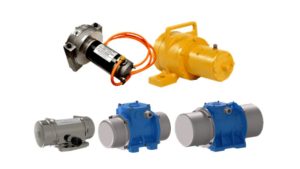Applications of Industrial Mechanical Vibrators
Industrial mechanical vibrators are crucial components in various industries, used to facilitate material handling, enhance productivity, and maintain equipment efficiency. These devices utilize vibration to move, shake, or consolidate materials and components, playing a pivotal role in operations ranging from bulk material handling to machinery maintenance. In this comprehensive guide, we will explore the diverse applications of industrial mechanical vibrators and their impact on different sectors.
1. Bulk Material Handling
One of the primary applications of industrial mechanical vibrators is in bulk material handling. These vibrators help to ensure smooth and efficient movement of materials through conveyors, hoppers, and chutes. By applying vibration, mechanical vibrators minimize material clumping and prevent blockages, ensuring a continuous flow of materials.
1.1. Conveyor Systems
Mechanical vibrators are often used in conveyor systems to enhance material flow. They help to reduce friction between materials and conveyor surfaces, preventing jams and ensuring consistent movement. This application is particularly useful in industries such as mining, agriculture, and manufacturing, where large volumes of materials need to be transported efficiently.
1.2. Hoppers and Chutes
In hoppers and chutes, mechanical vibrators aid in preventing material bridging and blockages. By applying vibrations, these devices ensure that materials flow smoothly from the hopper or chute into the next stage of processing or handling. This application is essential in industries such as construction and food processing, where material flow consistency is critical.
2. Vibration Testing and Conditioning
Mechanical vibrators are also used for vibration testing and conditioning of various equipment and products. This application is vital for quality control and product durability testing.
2.1. Product Durability Testing
Mechanical vibrators are employed to simulate the stresses and strains that products might experience during their operational life. By subjecting products to controlled vibrations, manufacturers can test their durability and identify potential weaknesses. This application is common in the automotive and aerospace industries, where product reliability is crucial.
2.2. Equipment Conditioning
In equipment conditioning, mechanical vibrators help to ensure that machinery and components are properly seated and aligned. Vibration helps to settle and align parts, reducing the likelihood of misalignment and improving overall equipment performance. This application is important in sectors such as manufacturing and packaging.

3. Compaction and Consolidation
Another significant application of mechanical vibrators is in compaction and consolidation processes. These devices help to compact materials and ensure uniform density, which is essential in various industrial processes.
3.1. Concrete Compaction
In the construction industry, mechanical vibrators are used to compact concrete in molds and forms. Vibrations help to remove air bubbles and ensure that the concrete settles evenly, resulting in a stronger and more durable final product. This application is critical for ensuring the structural integrity of concrete structures.
3.2. Powder and Granule Consolidation
Mechanical vibrators are used to consolidate powders and granules in industries such as pharmaceuticals and food processing. By applying vibrations, these devices help to ensure uniform packing and prevent segregation of materials. This application is essential for maintaining product consistency and quality.
4. Cleaning and Separation
Industrial mechanical vibrators are also employed in cleaning and separation processes. These devices assist in removing impurities and separating materials based on size and density.
4.1. Screening and Sifting
Mechanical vibrators are used in screening and sifting applications to separate materials based on size. Vibrating screens and sieves help to classify and sort materials, ensuring that only the desired particles pass through. This application is common in industries such as mining, recycling, and agriculture.
4.2. Parts Cleaning
In parts cleaning, mechanical vibrators are used to remove debris and contaminants from components. Vibrating cleaning machines use agitation to clean parts efficiently, which is essential in industries such as automotive and aerospace. This application helps to maintain the cleanliness and functionality of components. https://industrialvibration.com.au/mechanical-vibrator/
5. Vibratory Feeders and Dispensers
Vibratory feeders and dispensers are another key application of industrial mechanical vibrators. These devices use vibration to control the flow of materials and ensure precise dispensing.
5.1. Parts Feeding
Mechanical vibrators are used in parts feeding systems to ensure a consistent and controlled flow of components. Vibratory feeders help to orient and dispense parts for assembly or processing, improving efficiency in manufacturing lines. This application is crucial in industries such as electronics and automotive manufacturing.
5.2. Bulk Material Dispensing
In bulk material dispensing, mechanical vibrators help to regulate the flow of materials from storage bins or silos. By applying vibrations, these devices ensure that materials are dispensed evenly and without interruption, which is important for maintaining process efficiency in industries such as agriculture and chemicals.
6. Advantages of Industrial Mechanical Vibrators
The use of industrial mechanical vibrators offers several advantages, including improved efficiency, reduced downtime, and enhanced product quality.
6.1. Enhanced Efficiency
Mechanical vibrators help to improve the efficiency of various processes by ensuring smooth material flow, preventing blockages, and reducing the need for manual intervention. This leads to increased productivity and reduced operational costs.
6.2. Reduced Downtime
By preventing material blockages and ensuring consistent operation, mechanical vibrators help to reduce downtime and maintenance requirements. This leads to more reliable and uninterrupted operations, which is beneficial for maintaining production schedules.
6.3. Improved Product Quality
Mechanical vibrators contribute to improved product quality by ensuring uniform material flow, compaction, and cleaning. This results in higher-quality products and reduced defects, which is important for meeting customer expectations and regulatory standards.
Conclusion
Industrial mechanical vibrators play a vital role in various applications across multiple industries. From bulk material handling and compaction to cleaning and separation, these devices enhance efficiency, improve product quality, and reduce operational downtime. By understanding the diverse applications and benefits of mechanical vibrators, businesses can make informed decisions about their use and maximize their impact on operations.


